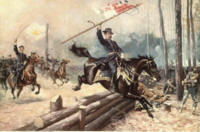Take an Audio Tour of the Battle of Antietam
 View Our Collection of Civil War Maps, Books and Films on CD and DVD |
The twelve hour Battle
of Antietam, the bloodiest day of the Civil
War began at dawn on September 17, 1862. For the next seven hours
there were three major Union attacks on the Confederate left, moving from
north to south. Gen. Joseph Hooker's command led the first Union assault.
Then Gen. Joseph Mansfield's soldiers attacked, followed by Gen. Edwin
Sumner's men as McClellan's plan broke down into a series of uncoordinated
Union advances. Savage, incomparable combat raged across the Cornfield,
East Woods, West Woods and the Sunken Road as Lee shifted his men to withstand
each of the Union thrusts. After clashing for over eight hours, the Confederates
were pushed back but not broken, however over 15,000 soldiers were killed
or wounded.
While the Union assaults were being made on the Sunken Road, a mile-and-a-half
farther south Union Gen. Ambrose Burnside opened the attack on the Confederate
right. His first task would be to capture the bridge that would later
bear his name. A small Confederate force, positioned on higher ground,
was able to delay Burnside for three hours. After taking the bridge at
about 1:00 p.m., Burnside reorganized for two hours before moving forward
across the arduous terrain--a critical delay. Finally the advance started
only to be turned back by Confederate General A.P. Hill's reinforcements
that arrived in the late afternoon from Harpers Ferry.
Neither flank of the Confederate army collapsed far enough for McClellan to advance his center attack, leaving a sizable Union force that never entered the battle. Despite over 23,000 casualties of the nearly 100,000 engaged, both armies stubbornly held their ground as the sun set on the devastated landscape. The next day, September 18, the opposing armies gathered their wounded and buried their dead. That night Lee's army withdrew back across the Potomac to Virginia, ending Lee's first invasion into the North. Lee's retreat to Virginia provided President Lincoln the opportunity he had been waiting for to issue the preliminary Emancipation Proclamation. Now the war had a dual purpose of preserving the Union and ending slavery.
You can now relive the battle of Antietam (in Sharpsburg, Maryland), the bloodiest day of the Civil War with a driving tour of the significant places of the battlefield. Stop by the Antietam Visitors Center before you start on this 8.5 mile driving tour to pick up a copy of the companion audio CD to highlight the significant events at every stop on the tour.
This tour will cover the following key historic points at Antietam.
Dunker Church - This was the focal point of repeated clashes as both armies sought to occupy and hold the high ground around it. Leveled by a storm in 1921, the church was rebuilt in 1962.
North Woods - General Hooker launched the initial Union attack from this
point. It was stopped by Jackson's troops in The Cornfield, 1/2 mile south.
East Woods - Union Gen. Joseph Mansfield was fatally wounded here ashe
led his XII Corps into battle.
The Cornfield - More fighting took place here in the Miller cornfield
than anywhere else at Antietam. The battle lines swept back and forth
across the field for three hours.
West Woods - Union Gen. John Sedgwick's division lost more than 2,200
men in less than half an hour in ill-fated charge into these woods-against
Jackson's and Longstreet's troops.
Mumma Farm - Burned by the Confederates to prevent their use by Union
sharpshooters, the Mumma farm buildings were the only civilian property
purposely destroyed during the battle.
Roulette Farm - Union troops under French and Richardson crossed these
fields on their way to meet the Confederates posted in the Sunken Road.
Sunken Road (Bloody Lane) - For nearly 4 hours, Union and Confederate
infantry contested this sunken country road, resulting in over 5,000 casualties--thus
the name "Bloody Lane."
Lower Bridge (Burnside Bridge) - The fighting here was a key factor in
McClellan's failure at Antietam. Called Burnside Bridge after the Union
general whose troops were held off most of the day by a few hundred Georgia
riflemen, it is the battlefield's best-known landmark.
The Final Attack - After taking the Lower Bridge and reforming his corps,
Burnside marched his men across these hills toward Sharpsburg, threatening
to cut off Lee's line of retreat. Just as the Federals reached this area,
A. P. Hill's Confederate division arrived from Harpers Ferry and drove
them back.
Antietam National Cemetery - The remains of 4,776 Federal soldiers, including 1,836 unknowns, are buried in this hilltop cemetery near town. Most of the Confederate dead are buried in Hagerstown and Frederick, Md., Shepherdstown, W. Va., and in local church and family cemeteries.

